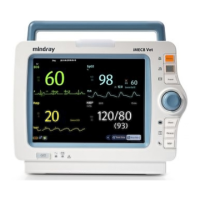8-13
8.7.2 Changing Arrhythmia Alarm Settings
To change arrhythmia alarm settings, select the ECG parameter area or waveform area →[ECG Setup]→ [Arrh.
Analysis >>]. In the pop-up menu, you can set the [Alm Lev] to [High], [Med], [Low] or [Message], or switch on lethal
arrhythmia analysis alarms only or switch on/off all arrhythmia analysis alarms. In the [Alarm Setup] menu from the
[User Maintenance] menu, you can enable/disable turning off lethal arrhythmia analysis alarms.
WARNING
If you switch off all arrhythmia analysis alarms, the monitor cannot give any arrhythmia analysis alarm.
Always keep the patient under close surveillance.
8.7.3 Changing Arrhythmia Threshold Settings
Select the ECG parameter window or waveform area→[Arrh. Analysis >>]→[Arrh. Threshold], and you can then
change threshold settings for some arrhythmia alarms. In case an arrhythmia violates its threshold, an alarm will be
triggered. The asystole delay time relates to ECG relearning. When HR is less than 30 bpm, it is recommended to set the
asystole delay time to 10 seconds.
Arrh. event Range Default Step Unit
PVCs High 1 to 100 10 1 /min
Asys. Delay
3 to 10 5
1 s
Tachy High 60 to 300 180 5 bpm
Brady Low 15 to 120 90 5 bpm
Extreme Tachy 120 to 300 200 5 bpm
Extreme Brady 15 to 60 60 5 bpm
Multif. PVC's Window 3 to 31 15 1 /min
Vtac Rate 100 to 200 160 5 bpm
Vtac PVCs 3 to 99 6 1 /min
Pause Time 1.5, 2.0,2.5 2 / s
Vbrd PVCs 3 to 99 5 1 /min
Vbrd Rate 15 to 60 40 5 bpm
8.7.4 Setting the Extended Arrhythmia
The following arrhythmia events are defined as extended arrhythmia:
Extreme Tachy
Extreme Brady
Vent. Brady
Nonsus. Vtac
Multif. PVC
Irr. Rhythm
Pause
You can select [Main Menu]→[Maintenance >>]→[User Maintenance >>]→enter the required password→select
[Alarm Setup >>], and set [Extended Arrh.] to [Enable] or [Disable]. When [Extended Arrh.] is set to [Disable], the
monitor does not analyze the extended arrhythmia events and corresponding alarms are not given.

